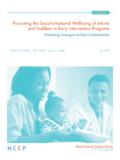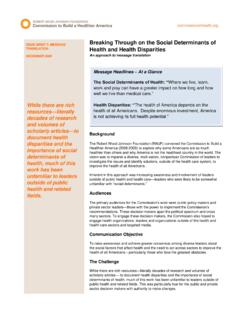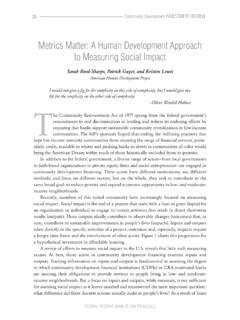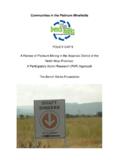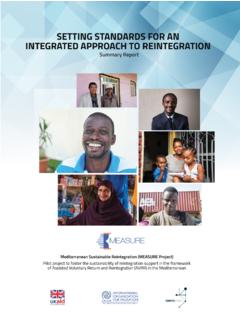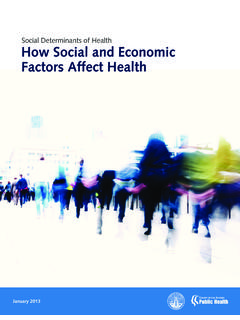Transcription of Measuring Socially Sustainable Urban Regeneration in …
1 1 Creating Sustainable Environments Measuring Socially Sustainable Urban Regeneration in Europe October 2009 Main Authors: Andrea Colantonio and Tim Dixon Contributing Authors: Robin Ganser, Juliet Carpenter and Austine Ngombe Oxford Institute for Sustainable Development (OISD) School of the Built Environment Oxford Brookes University This project has received EIB funding through their EIBURS programme 2 The research ( Measuring the Social Dimension of Sustainable Development) upon which this report is based was funded the EIBURS (European Investment Bank University Research Sponsorship) Programme in 2006. The study was carried out between January 2007 and August 2009 by a team from the Oxford Institute for Sustainable Development, School of the Built Environment, Oxford Brookes University, who also wrote this report.
2 The team includes: Professor Tim Dixon* Project Director Dr Andrea Colantonio* Project Manager and Lead researcher Dr Robin Ganser Case Study Researcher -Leipzig Dr Juliet Carpenter Researcher EU affairs Austine Ngombe Case Study Research Assistant - Cardiff Professor John Glasson Advisor The team also received valuable advice and support from Mateu Turro, Projects Directorate at the EIB, who was the main EIBURS referent for this project. Oxford Institute for Sustainable Development (OISD) School of the Built Environment Oxford Brookes University Gipsy Lane Headington Oxford OX3 0BP (Note: the views expressed in this report are those of the main authors and not of the Institute as a whole) * corresponding authors. Email: and 3 Executive Summary Background Previous research on sustainability has been mainly limited to environmental and economic concerns.
3 However in recent years social sustainability has gained increased recognition as a fundamental component of Sustainable development, beginning to receive political and institutional endorsement within the Sustainable development agenda, and the Sustainable Urban Regeneration discourse. Indeed, in the 1980s, Regeneration projects focused mainly on the physical and economic renewal of degraded inner-city areas. However, since the 1990s across the EU, this approach to Urban Regeneration emphasising the environmental and economic spheres of Regeneration has been replaced by a more integrated approach to Urban redevelopment, which linked the stimulation of economic activities and environmental improvements with social and cultural elements. Rationale The delivery of Sustainable Urban development has moved to the heart of European Urban policy through the development of several policy documents and agreements, including the 1998 document Urban Sustainable Development in the EU: A Framework for Action , the 2005 Bristol Accord and the 2007 Leipzig Charter on Sustainable European Cities.
4 Although a growing recognition of social sustainability has spurred an emerging body of research and policy literature, our understanding of this concept is still fuzzy and limited by theoretical and methodological constraints stemming from its context and disciplinary-dependent interpretations. Furthermore, at a practice level, tools, instruments and metrics to foster Sustainable Urban development currently available are biased toward environmental and economic sustainability. As a result, there is a clear need for further research on both social sustainability and its measurement in the context of Sustainable Urban Regeneration . Aims and Objectives The main objectives of the research were to: define social sustainability and explore the main themes and dimensions at the heart of this concept, in the context of EU cities; examine to what extent, and in what ways, social sustainability is incorporated within Urban renewal projects within the EU; critically review governance models and vehicles, which seek to deliver Socially Sustainable communities in Urban areas, with special emphasis on Public Private Partnerships (PPPs); analyse the current sustainability indicators and tools used by the public, private and Non Governmental Organisation sectors to deliver social sustainability; and examine and identify best practices to measure and monitor Socially Sustainable Urban Regeneration .
5 Methodology The research methodology comprised an initial literature review and structured interviews, which were followed by fieldwork and case study analysis. The literature reviews and the interviews explored the notion of social sustainability, together with its main research approaches, assessment methods and indicators. These elements of work also examined the importance of social sustainability in the contexts of Urban 4regeneration, public private partnerships and EU Urban policy. Following the elaboration of the theoretical research framework, five case studies were selected after an in-depth review of over 50 Urban Regeneration projects across the EU. These included Regeneration schemes in the cities of Cardiff (UK), Rotterdam (NL), Turin (IT), San Adri de Besos (ES) and Leipzig (DE).
6 These projects were selected because it was felt that they could provide examples of best practice or exemplify the lessons learned from an integrated approach to Regeneration and the related measurement of social sustainability. In the final stages of the research project, both the literature review and the case study analysis were instrumental in producing a social sustainability assessment framework, which is the first of its kind in the context of Urban Regeneration in EU cities. Main Findings Definition of social sustainability Social sustainability concerns how individuals, communities and societies live with each other and set out to achieve the objectives of development models which they have chosen for themselves, also taking into account the physical boundaries of their places and planet earth as a whole.
7 At a more operational level, social sustainability stems from actions in key thematic areas, encompassing the social realm of individuals and societies, which ranges from capacity building and skills development to environmental and spatial inequalities. In this sense, social sustainability blends traditional social policy areas and principles, such as equity and health, with emerging issues concerning participation, needs, social capital, the economy, the environment, and more recently, with the notions of happiness, well being and quality of life. Social Sustainability in Current Urban Regeneration Policies and Practices Urban Regeneration projects can generate potential outputs and outcomes at least in the following 10 social sustainability dimensions and policy areas: - Demographic change (ageing, migration and mobility); - Education and skills; - Employment; - Health and safety; - Housing and environmental health; - Identity, sense of place and culture; - Participation, empowerment and access; - Social capital; - Social mixing and cohesion; and, - Well being, happiness and quality of life.
8 These are critical areas for the social sustainability of local communities and neighbourhoods, and it is of fundamental importance to assess the potential direct and indirect impact that Urban Regeneration project proposals are likely to generate for them. Critical Success Factors to Deliver Socially Sustainable Urban Regeneration Single task ad hoc agencies and public private partnerships (PPPs) are beneficial vehicles to deliver self-sustaining and Socially Sustainable Urban Regeneration projects. In addition, a well-resourced and integrated approach to Regeneration supported by diversified and continuing funding is crucial to deliver Sustainable communities and avoid piecemeal interventions. There is also evidence from the empirical work in this research that the location of the Regeneration agency offices in the areas being regenerated also have beneficial effects, because they can guarantee a forum for discussion and transparency, helping reduce mistrust towards city authorities, which often characterises these areas.
9 5 Image and branding are crucial for the social Regeneration of city areas. Indeed, neighbourhoods undergoing Urban Regeneration have often acted as recipient areas for low-income newcomers to the city because of their affordable rents and lower cost of living. Regeneration projects are therefore trying to improve the image of these places in order to attract new inward-investments in social, economic and green infrastructure, as well as middle-high income people to these neighbourhoods. It is crucial, however, that Regeneration projects include the development of adequate infrastructure and services for the integration of newcomers and external investors by organising, for example, workshops and networking events. Similarly, it is of fundamental importance for municipal authorities to have plans in place to minimise the involuntary displacement effect that higher income people may have on local communities in terms of housing and local economic activities and services.
10 Best Practice in Social Sustainability Monitoring Systems The tools, instruments and metrics to foster Sustainable communities currently available are biased toward environmental sustainability. Municipal authorities have begun to experiment with the use of composite indices, such as the Sociale Index , which integrate different social dimensions together to measure and monitor the social evolution of places. On the one hand, these indices can provide powerful concise visual indications concerning the social qualities of places and their evolution over time. On the other, aggregated indices may run the risk of providing superficial social representations of places and communities, whose social performance is summarised and compared through single numerical values. Low scores in such indices, for example, could lead to the stigmatisation of some areas through over-simplistic comparisons.
